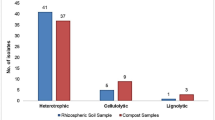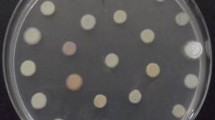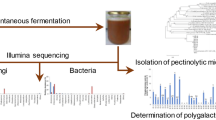Abstract
The persistent edaphic stress on microbial succession due to dynamic changes during composting was explored for selection of multi-stress tolerant microbe(s) desirable for ethanol production. A total of 23 strains were isolated from mango compost using four successive enrichments in YP broth (g l−1): glucose, 100; 150; 250 with ethanol (40) and cycloheximide (0.4) at 40 °C, pH 6.0. Based on multi-gene ribotyping, 14 yeasts (61 %) of Saccharomycetaceae, 2 filamentous fungi (8.6 %) and 7 bacteria (30.4 %) were obtained. Phenetic and phylogenetic analysis of the 14 yeasts revealed 64.3 % tolerant to 500 g l−1 glucose, growth at 45 °C and resemblance to Candida sp. (14.3 %), Kluyveromyces marxianus (35.7 %), Pichia kudriavzevii (21.4 %) and Saccharomyces cerevisiae (28.6 %). Assessment of the 14 yeasts in glucose fermentation medium (pH 4.5 at 40 °C) showed ethanol productivity of ≥92 % by 12 yeasts with theoretical yields of 90–97 %. Fermentation of molasses (150 g l−1 glucose equivalent) by P. kudriavzevii D1C at 40 °C resulted in 73.70 ± 0.02 g l−1 ethanol and productivity of 4.91 ± 0.01 g l−1 h−1. Assessment of P. kudriavzevii D1C revealed multi-stress tolerance towards 5-hydroxymethyl furfural, ethanol (20 %, v/v), high gravity and H2O2 (0.3 M) indicating suitability for ethanol production using high gravity molasses and pre-treated lignocellulosic biomass fermentation.




Similar content being viewed by others
References
Ajila CM, Bhat SG, Prasada Rao UJS (2007) Valuable components of raw and ripe peels from two Indian mango varieties. Food Chem 102:1006–1011
Anderson PJ, McNeil K, Watson K (1986) High-efficiency carbohydrate fermentation to ethanol at temperatures above 40 °C by Kluyveromyces marxianus var. marxianus isolated from sugar mills. Appl Environ Microbiol 51:1314–1320
Ausubel FM, Brent R, Kingston RE, Moore DD, Seidman JG, Smith JA, Struhl K (2003) Current protocols in molecular biology. Wiley, Hoboken
Balat M, Balat H (2009) Recent trends in global production and utilization of bio-ethanol fuel. Appl Energy 86:2273–2282
Banat IM, Nigam P, Marchant R (1992) Isolation of thermotolerant fermentative yeasts capable of growth at 52 °C and ethanol production at 45 °C and 50 °C. World J Microbiol Biotechnol 8:259–263
Banat IM, Nigam P, Singh D, Marchant R, McHale AP (1998) Review: ethanol production at elevated temperatures and alcohol concentrations: Part I—yeasts in general. World J Microbiol Biotechnol 14:809–821
Banerjee N, Bhatnagar R, Viswanathan L (1981) Development of resistance in Saccharomyces cerevisiae against inhibitory effects of Browning reaction products. Enzyme Microb Technol 3:24–28
Blieck L, Toye G, Dumortier F, Verstrepen KJ, Delvaux FR, Thevelein JM, Van Dijck P (2007) Isolation and characterization of brewer’s yeast variants with improved fermentation performance under high-gravity conditions. Appl Environ Microbiol 73:815–824
Brooks AA (2008) Ethanol production potential of local yeast strains isolated from ripe banana peels. Afr J Biotechnol 7:3749–3752
Çakar ZP, Seker UOS, Tamerler C, Sonderegger M, Sauer U (2005) Evolutionary engineering of multiple-stress resistant Saccharomyces cerevisiae. FEMS Yeast Res 5:569–578
Chaudhari AB, Dandi ND, Vadnere NC, Patil UK, Chincholkar SB (2012) Bioethanol: a critical appraisal. In: Satyanarayana T, Johri BN, Prakash A (eds) Microorganisms in sustainable agriculture and biotechnology. Springer, Berlin, pp 793–824
Choi MH, Park YH (1998) The influence of yeast on thermophilic composting of food waste. Lett Appl Microbiol 26:175–178
Dhaliwal SS, Oberoi HS, Sandhu SK, Nanda D, Kumar D, Uppal SK (2011) Enhanced ethanol production from sugarcane juice by galactose adaptation of a newly isolated thermotolerant strain of Pichia kudriavzevii. Bioresour Technol 102:5968–5975
Eaton AD, Franson MAH, American Public Health Association (2005) Standard methods for the examination of water & wastewater, 21st edn. American Public Health Association, Washington, DC
Fracchia L, Dohrmann AB, Martinotti MG, Tebbe CC (2006) Bacterial diversity in a finished compost and vermicompost: differences revealed by cultivation-independent analyses of PCR-amplified 16S rRNA genes. Appl Microbiol Biotechnol 71:942–952
Gallardo JC, Souza CS, Cicarelli RM, Oliveira KF, Morais MR, Laluce C (2011) Enrichment of a continuous culture of Saccharomyces cerevisiae with the yeast Issatchenkia orientalis in the production of ethanol at increasing temperatures. J Ind Microbiol Biotechnol 38:405–414
Gardner JG, Zeitler LA, Wigstrom WJS, Engel KC, Keating DH (2012) A high-throughput solid phase screening method for identification of lignocellulose-degrading bacteria from environmental isolates. Biotechnol Lett 34:81–89
Harju S, Fedosyuk H, Peterson KR (2004) Rapid isolation of yeast genomic DNA: Bust n’ Grab. BMC Biotechnol. doi:10.1186/1472-6750-4-8
Hisamatsu M, Furubayashi T, Karita S, Mishima T, Isono N (2006) Isolation and identification of a novel yeast fermenting ethanol under acidic conditions. J Appl Glycosci 53:111–113
Horwitz W (1975) Official methods of analysis of the association of official analytical chemists, 12th edn. Association of Official Analytical Chemists, AOAC International, Washington, DC, p 572
Kiransree N, Sridhar M, Suresh K, Banat IM, Rao LV (2000a) Isolation of thermotolerant, osmotolerant, flocculating Saccharomyces cerevisiae for ethanol production. Bioresour Technol 72:43–46
Kiransree N, Sridhar M, Rao LV (2000b) Characterisation of thermotolerant, ethanol tolerant fermentative Saccharomyces cerevisiae for ethanol production. Bioprocess Biosyst Eng 22:243–246
Kitagawa T, Tokuhiro K, Sugiyama H, Kohda K, Isono N, Hisamatsu M, Takahashi H, Imaeda T (2010) Construction of a beta-glucosidase expression system using the multistress-tolerant yeast Issatchenkia orientalis. Appl Microbiol Biotechnol 87:1841–1853
Kurtzman CP (1992) Minireview: rRNA sequence comparisons for assessing phylogenetic relationships among yeasts. Int J Syst Bacteriol 42:1–6
Kurtzman CP, Robnett CJ (1998) Identification and phylogeny of ascomycetous yeasts from analysis of nuclear large subunit (26S) ribosomal DNA partial sequences. Antonie Leeuwenhoek 73:331–371
Kurtzman CP, Robnett CJ, Basehoar-Powers E (2008) Phylogenetic relationships among species of Pichia, Issatchenkia and Williopsis determined from multigene sequence analysis, and the proposal of Barnettozyma gen. nov., Lindnera gen. nov. and Wickerhamomyces gen. nov. FEMS Yeast Res 8:939–954
Kurtzman CP, Fell JW, Boekhout T (2011) The yeast, a taxonomic study, 5th edn. Elsevier, New York
Laopaiboon L, Nuanpeng S, Srinophakun P, Klanrit P, Laopaiboon P (2009) Ethanol production from sweet sorghum juice using very high gravity technology: effects of carbon and nitrogen supplementations. Bioresour Technol 100:4176–4182
Lewis JG, Learmonth RP, Attfield PV, Watson K (1997) Stress co-tolerance and trehalose content in baking strains of Saccharomyces cerevisiae. J Ind Microbiol Biotechnol 18:30–36
Limtong S, Stringiew C, Yongmanitchai W (2007) Production of fuel ethanol at high temperature from sugarcane juice by a newly isolated Kluyveromyces marxianus. Bioresour Technol 98:3367–3374
Miller GL (1959) Use of dinitrosalicylic acid reagent for determination of reducing sugar. Anal Chem 31:426–428
Nevoigt E (2008) Progress in metabolic engineering of Saccharomyces cerevisiae. Microbiol Mol Biol Rev 72:379–412
Oberoi HS, Babbar N, Sandhu SK, Dhaliwal SS, Kaur U, Chadha BS, Bhargav VK (2012) Ethanol production from alkali-treated rice straw via simultaneous saccharification and fermentation using newly isolated thermotolerant Pichia kudriavzevii HOP-1. J Ind Microbiol Biotechnol 39:557–566
Pang ZW, Liang JJ, Qin XJ, Wang JR, Feng JX, Huang RB (2010) Multiple induced mutagenesis for improvement of ethanol production by Kluyveromyces marxianus. Biotechnol Lett 32:1847–1851
Pereira FB, Guimarães PMR, Teixeira JA, Domingues L (2010) Selection of Saccharomyces cerevisiae strains for efficient very high gravity bio-ethanol fermentation processes. Biotechnol Lett 32:1655–1661
Peres MFS, de Sousa SR, Laluce C (2001) Obtaining strains of Saccharomyces tolerant to high temperatures and ethanol. In: Spencer JFT, Spencer ALR (eds) Food microbiology protocols. Humana Press Inc., Totowa, pp 355–367
Peters S, Koschinsky S, Schwieger F, Tebbe CC (2000) Succession of microbial communities during hot composting as detected by PCR-single-strand-conformation polymorphism-based genetic profiles of small-subunit rRNA genes. Appl Environ Microbiol 66:930–936
Rao RS, Bhadra B, Shivaji S (2008) Isolation and characterization of ethanol-producing yeasts from fruits and tree barks. Lett Appl Microbiol 47:19–24
Ryckeboer J, Mergaert J, Vaes K, Klammer S, de Clercq D, Coosemans J, Insam H, Swings J (2003) A survey of bacteria and fungi occurring during composting and self-heating processes. Ann Microbiol 53:349–410
Ryohei U, Naoko H-S, Naoto U (2003) Fermentation of molasses by several yeasts from hot spring drain and phylogeny of the unique isolate producing ethanol at 55 °C. J Tokyo Univ Fish 3:23–30
Tamura K, Peterson D, Peterson N, Stecher G, Nei M, Kumar S (2011) MEGA5: Molecular Evolutionary Genetics Analysis using maximum likelihood, evolutionary distance, and maximum parsimony methods. Mol Biol Evol. doi:10.1093/molbev/msr121
van Maris AJA, Abbott DA, Bellissimi E, van den Brink J, Kuyper M, Luttik MAH, Wisselink HW, Scheffers WA, van Dijken JP, Pronk JT (2006) Alcoholic fermentation of carbon sources in biomass hydrolysates by Saccharomyces cerevisiae: current status. Antonie Leeuwenhoek 90(4):391–418
Watanabe T, Srichuwong S, Arakane M, Tamiya S, Yoshinaga M, Watanabe I, Yamamoto M, Ando A, Tokuyasu K, Nakamura T (2010) Selection of stress-tolerant yeasts for simultaneous saccharification and fermentation (SSF) of very high gravity (VHG) potato mash to ethanol. Bioresour Technol 101:9710–9714
White TJ, Bruns T, Lee S, Taylor J (1990) Amplification and direct sequencing of fungal RNA genes for phylogenetics. In: Innis MA, Gelfand DH, Sninsky JJ, White TJ (eds) PCR protocols: a guide to methods and applications. Academic Press Inc., New York, pp 315–322
Acknowledgments
The assistance rendered by Mr. Pradeep Suryavanshi, Jain Irrigation Systems Ltd., Jalgaon, India for CO2 analysis of samples and Dr. G. S. Prasad, Microbial Type Culture Collection and GeneBank, Chandigarh, India for phenetic analysis of isolates is acknowledged. Mr. N. D. Dandi is grateful to Dr. Yogesh Shouche and Mr. Arvind Gupta, National Center for Cell Sciences, Pune, India for facilitating rDNA sequencing of the isolates under INSA Visiting Fellowship (Indian National Science Academy, New Delhi). Authors are also thankful to University Grants Commission and Department of Science and Technology, New Delhi for funding under SAP and FIST program, respectively to the institute.
Author information
Authors and Affiliations
Corresponding author
Electronic supplementary material
Below is the link to the electronic supplementary material.
Rights and permissions
About this article
Cite this article
Dandi, N.D., Dandi, B.N. & Chaudhari, A.B. Bioprospecting of thermo- and osmo-tolerant fungi from mango pulp–peel compost for bioethanol production. Antonie van Leeuwenhoek 103, 723–736 (2013). https://doi.org/10.1007/s10482-012-9854-4
Received:
Accepted:
Published:
Issue Date:
DOI: https://doi.org/10.1007/s10482-012-9854-4




